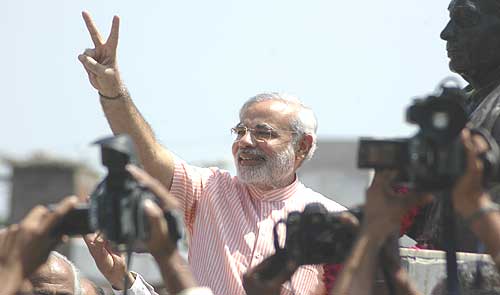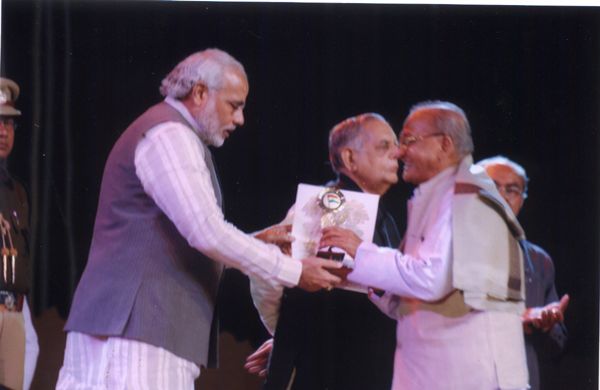Will Jayalalitha and Narendra Modi team up?

THE ERSTWHILE
chief minister of
Tamil Nadu J
Jayalalitha is anxiously waiting for a superstar visitor to delight her at her sprawling Poes Garden residence in Chennai during Pongal, a festival celebrated as ‘Tamils’ great day’ by all communities of
Tamil Nadu. Wait a minute! It is not that the evergreen superhero of southern cinema Rajnikant has been motivated to break his resolve not to jump into politics by lesser mortals like Vijaykanth and Sarathkumar. Even if he does, it is unlikely that he will throw his lot with her Dravidian party.
She is no more the bewitching glamour girl that she used to be in yesteryear’s Tamil cinema, although one does frequently get to watch her exciting gyrations to lilting tunes in movie clips shown on the small screen. She is better known as Amma (mother) by her fans after she plunged into politics. No wonder, the hero she is now wooing is the most famous poster boy of politics, Narendra Damodarbhai Modi of Gujarat. The reigning superstar of Indian politics and Gujarat’s third-time
chief minister, it is rumoured, will have the honour of lunching with the lady on the Pongal day. A couple of ‘national’ newspapers have even speculated on the mouth-watering menu for the rendezvous!
Pongal falls on January 14 every year, the day that is celebrated by most ancient societies on earth, because it marks the northward shift of the earth’s orbit with respect to the Sun. It is an auspicious day to launch new ventures. In
Tamil Nadu, which is served by the northeast monsoon, Pongal marks thanksgiving to the sun God, post-harvest. It is as important as the Holi festival of the north, which signifies the harvest engendered by the southwest monsoon. Everyone wears new clothes on the occasion and enjoys a delicacy called Pongal, prepared from the just-harvested rice. It is served along with an exotic side dish called Avial, made from several vegetables and edible roots.
Gujaratis, whose main festival is Diwali, celebrate January 14 as the Uttarayan festival, although not as grandly as the Tamils. Everyone enjoys this day, including Muslims and Christians, relishing Jalebis and flying kites. They eat a spicy variation of the Avial, named Undhio, and also made from an assortment of vegetables and roots.
Greeting newspersons on New Year’s Eve,
Jayalalitha broke the news of Modi’s proposed Pongal visit. The general secretary of AIADMK (All India Anna Dravida Munnetra Kazhagam) claimed that the BJP leader, recently elevated to the strategy-chalking wing of the BJP, would call on her at her Poes Gardens residence. She said that Modi informed her that he would visit Chennai on January 14. Even though Modi is not supposed to be visiting Chennai to meet her, such a meeting cannot be ruled out either. Modi has a tentative private programme for the day - to participate in the anniversary celebrations of a media company and receive from it the ‘Person of the Year’ award. Moreover, he can finalise his full ministerial team only after a good
muhurat, which is available only post-Uttarayan. Bogged down in the arduous ministry-making job, one is not sure whether he will at all find time to make the trip.
Jayalalitha, however, seems to be keen on hooking Modi, whom she called her “friend.” She quipped, “It is natural to call up a friend and congratulate him when he achieves victory” and said she had earlier attended his oath-taking ceremony.
The AIADMK supremo has in fact been the first politician to rush to compliment Modi after his victory last month. She promptly sent him a congratulatory message in English, which was typically verbose: “I have no doubt that under your strong and inspiring leadership, Gujarat will rise to greater heights of all round progress and development . . . Your spectacular victory has brought hope and cheer to the vast majority of people in this nation, who now believe that all is not lost and that India can still be saved from the clutches of unscrupulous power mongers.” The oblique reference was to Congress chief Sonia Gandhi, who’s slain husband Rajiv had played a key role in her ascendance!
The heavyweight political leader of
Tamil Nadu, however, is not the only one trying to court BJP. Modi’s stunning third-time win, braving a ruthless onslaught unleashed against him by rivals within and without and the media has made several people to sit up and take notice of him. Most of them belong to parties currently outside the BJP-led NDA.
Bihar strongman Lalu Prasad Yadav reacted to the ‘spectacular’ win, saying, “We are not at all surprised by the spectacular victory pulled off by BJP in Gujarat because it was led by
Narendra Modi. The Congress committed a blunder by giving party tickets to those who parted company with Modi and joined it.” Ajay Chautala, heir-apparent of the Haryana outfit INLD (Indian National Lok Dal), led by Om Prakash Chautala, made himself conspicuous at the dais during the swearing-in ceremony.
It is said that anything can happen in politics; more so in a drama theatre where the play is enacted by over four dozen foolish drama companies that keep on fragmenting and switching allegiance. But, the coming together of
Jayalalitha and
Narendra Modi would be particularly comical because they make incredibly strange bedfellows. They are poles apart.
Modi started off as a grassroots worker of RSS (Rashtriya Swayamsevak Sangh) at the age of 24 and rose through hard social work and determination. He joined BJP in the 1980s after remaining an RSS cadre for several years and coordinating RSS-BJP relations. When he was appointed general secretary of the Gujarat state BJP unit, he had acquired 15 years of experience. Modi has been known as an organisation man throughout his career and was elevated as national secretary of the party at the age of 45. He was asked by the party in 2001 to head the government in a battered Gujarat; severe natural calamities, including the massive 2001 earthquake, had left the BJP-ruled state devastated. He managed the situation admirably and put the state atop, both economically and socially. The only charge that can be held against him was the controversial anti-Muslim pogrom in the aftermath of the Godhra carnage, which he initially tried to dismiss as another of the numerous riots that occurred in India after 1947.
Despite attracting copious investments to the state, Modi has maintained a clean image. None of his relatives can be cited for cashing in on his power. He is noted for his ruthless ways in dealing with indiscipline and mal-administration by corrupt officials and party men. His unwavering loyalty to social work is beyond question and he has never compromised for the sake of power. In fact, the third mandate he won recently was in the face of a huge rebellion by influential BJP chieftains, including his one-time mentor, whom he tried to discipline.
In contrast,
Jayalalitha, two years older than the determined self-made leader of Gujarat, is noted for being a bit of a show off; she is also noted for her ostentatious lifestyle. The marriage of her adopted son (who later ditched her) is one of the most vulgarly expensive wedding ceremonies of India. Her regime in 1991-96 faced severe charges of corruption and malfeasance. Amassing of wealth by her ministers and an extraordinary female partner, led to her downfall. The entire ministerial team, including Jaya herself, was trounced in the 1996 elections, with six of the ministers even losing their deposits. She was convicted of embezzlement and sentenced to five years rigorous imprisonment by a court; all the same, she continued as
chief minister unconstitutionally, till the Supreme Court directed her to step down. The apex court later acquitted her in the specific case of monetary fraud, citing lack of ‘conclusive’ evidence to convict her. She is fighting more cases, hiring the best legal brains, thanks to her colossal wealth.
Early on in her life, she was a popular heroine and owes it to her relationship with former matinee idol and
Tamil Nadu chief minister MG Ramachandran. She was his movie heartthrob and was 33 years old when she joined the AIADMK. MGR straightaway nominated her to the Rajya Sabha, although she did not have much of political exposure. When he died three years later, she controversially inherited his fortune, casting off his wife by the wayside.
Interestingly,
Jayalalitha’s association with the BJP is not new. When AB Vajpayee ventured to form the second NDA government in 1998 with a slender support, her frequent tantrums kept him on a tight leash. It was her non-cooperation that led to the government’s eventual collapse in 13 months, whence Vajpayee depended on NDA convener George Fernandes to cling to power. George donned the unenviable role of ‘peace broker’ and rushed to Poes Garden to cool her and iron out the differences. She has had a blow hot, blow cold relationship with Congress too, allying with it and ditching it at her convenience. Two of her current allies are the PMK (Pattali Makkal Katchi) and MDMK (Marumalarchi Dravida Munnetra Kazhagam). The first one is better known as the abode of union health minister Anbumani Ramadoss and his mercurial father; she charmed the MDMK, the staunchest supporter of LTTE in India, after putting its leader behind bars for treason during her regime.
The BJP hardly has any following south of the Vindhyas, except in some pockets in Karnataka. People cannot accept its theme of Hindu Rashtra as it is viewed in the context of the Aryan subjugation of Dravidians, ages ago. However, it is at least seen as a disciplined outfit. It will lose any chance of gaining a presence if that image is shattered.
Jayalalitha’s background is more or less similar to Indira Gandhi’s, in terms of autocratic behaviour; in terms of public image it is more or less similar to Lalu Prasad’s. She may be a match for BJP only when the likes of Uma Bharati (who started BJS or the Bhartiya Jana Shakti Party, when she was not allowed by BJP to continue as Madhya Pradesh
chief minister), are taken back and allowed to call the shots. It will be a tragedy if she succeeds in charming
Narendra Modi, who is just her opposite.






